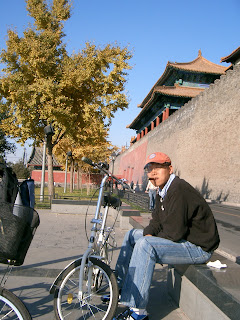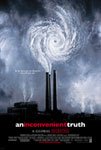
A 100-minute movie about one presentation delivered by a politican on global warming. This description is basically what '
An Inconvenient Truth' is about. Well, such description does not sound very attractive by itself - long presentation, speech by a politican... and it is about global warming.... oh no!! However, if you notice how popular this movie is, you can imagine that there must be something great about this presentation, amid the factual description at the beginning of this paragraph.
Yes, there have been a lot of discussion and attention on this movie, in many aspects. Of course, the main message delivered by the presentation / movie is one - how important it is for us to act now to stop global warming!! On the other hand, it is facinating to have Al Gore to spend so much of his time, effort and will (since not many other politicans or large corporation would love his speech) to deliver this presentation, and thus the above message.
For me, it is also how the presentation was conducted. Other website site like
presentationzen.com have staged a lot of discussion and view on this movie. And let me offer mine here. In short, my comment on this presentation - 'It is a 100% must-watchfor those who is serious to learn about presentation skills'. I think it is close to perfect - let me highlight a few points:
Preparation - I always say that preparation is the single most important success factor in presentation. Al Gore is definitely prepared. You can see from the presentation that he knows the content very very well e.g. at a point, his speech is in pace with the automatic count down of years on the chart, and he does not have to look at the chart. In fact, he mentioned in the movie that he has made the presentation almost 1,000 times. (Not that we have to do 1,000 times, but you should be able to get familiarized with your content after say 10 times. Yet, I still see a lot of colleagues in my organisation I am working in failing to comprehend his / her visual aid and content as they deliver their 80%-similar sales pitch the 11-times.)
 Visual Aid -
Visual Aid - The slides are assisting his arguments. But at work, the slides are replacing or even prohibiting colleagues' arguments. Al Gore does it by showing the visual aid at the right time - mostly deliver your verbal arguments first, and then show your aid - not the opposite (which is common among our colleagues). On the other hand, the pictures are of high quality e.g. the earth photos in the beginning and relevant e.g. the balance at Chapter 28. In particular, I love the chart he used at the end to demonstrate how the CO2 emission can be reduced by various actions he suggested. They way he (or his team) designed and used the chart is simply an art - to show the contrast, to get the message across!!! In addition, he uses good variety of visual aid - comics, picture, chart, quote... and almost ZERO word slides!!
Movement / Set Up - The moment Al Gore used the elevating machine for him to point out what the world temperature will become - the message cannot be more clear!!
Opening - With a high-resolution earth picture in the dark room catching everyone's attention, emotionally
Ending - Asking for an action and appealing to the positive i.e. "All of us can make a difference to stop global warming"
I shall discuss in more details of specific presentation learning points from this movie..... stay tuned.
 I feel quite ashamed that I did not focus on this purpose before in my basic presentation class, because it should be obvious. Why obvious? Here is the logic. What will be a successful presentation class? Simple - the participants deliver better presentation after the class. Then, the question is what stop them from delivering better presentation. For the beginner, the lack of confidence is definitely an obstacle.
I feel quite ashamed that I did not focus on this purpose before in my basic presentation class, because it should be obvious. Why obvious? Here is the logic. What will be a successful presentation class? Simple - the participants deliver better presentation after the class. Then, the question is what stop them from delivering better presentation. For the beginner, the lack of confidence is definitely an obstacle.







